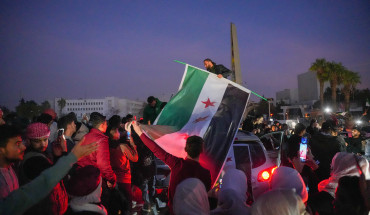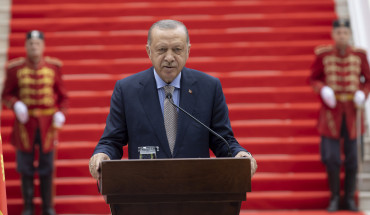The Syrian Army and Iranian-led forces have captured Abu Kamal, a strategic border town in eastern Syria and the last major ISIS stronghold in the country, Iranian and Arab media report. While the physical and military defeat of the Islamic State is good news, the rapid territorial gains by pro-Syrian regime forces, particularly in the oil-rich eastern province of Deir Ezzor, have increased the risk of a potential confrontation with U.S.-backed Syrian opposition forces that have also captured strategic areas from ISIS in northern and eastern Syria. Lately, Iranian and Syrian officials have been threatening to take on Syrian Democratic Forces in Deir Ezzor and Raqqa provinces after dislodging ISIS from its last pockets in the east – setting the stage for a “direct confrontation” with the U.S. military that backs the S.D.F. and other Syrian opposition groups. Washington, however, has not made it clear if it will remain committed to defending Syrian opposition forces from pro-regime forces once the fight against ISIS in Syria and Iraq is over.
Liberation of Abu Kamal
“The last stronghold of Daesh (Islamic State), Albu Kamal, is free of the Daesh organization,” several media organizations quoted a commander in the pro-Damascus alliance as saying just hours ago. The U.K.-based Syrian Observatory for Human Rights, however, disputed the claim, adding that fighting was still going on in the area.
Earlier today, the Iranian press reported that the Syrian Army and Iranian-sponsored militia groups – supported by Russian air power – have laid a “complete siege” on Islamic State fighters in Abu Kamal. Video footages circulating in social media also showed militiamen from Lebanese Hezbollah and two Iraqi Shiite groups – Kata’ib Hezbollah and Harakat al-Nujaba – linking up with the Syrian Army along the Syrian-Iraqi border – suggesting that Iranian-sponsored Iraqi militia groups that had helped liberate the Iraqi border town of al-Qaim entered Syria to take part in the Abu Kamal operation.
On November 4, the spokesman for Kata’ib Hezbollah – also known as the Iraqi Hezbollah or Hezbollah Brigades – said the group will participate in a joint operation with pro-Damascus forces to seize Abu Kamal. Speaking to Lebanese TV al-Mayadeen, Jafaar Hussaini stressed that the seizure of al-Qaim on the Iraqi side foiled U.S. “plot” to “disconnect the axis of resistance” in Iraq and Syria.
Confrontation with U.S.
The Syrian Army and Iranian-led forces had recently launched two operations to encircle Abu Kamal: one from al-Mayadin and another from T-2 pumping station near the Iraqi border. But the reinforcements from Iraq were meant to preempt U.S.-backed Syrian Democratic Forces (S.D.F.) from reaching Abu Kamal. Recently, Iranian media have been warning that the United States will push S.D.F. forces to take Abu Kamal, due to its strategic positioning on the Euphrates and its proximity to the Iraqi border, even if it leads to clashes with Iranian-backed forces.
And on Monday, Iran’s Fars News Agency, which is affiliated with the Islamic Revolution Guards Corps (I.R.G.C.), warned that “direct confrontation” between pro-Damascus forces and the U.S.-backed S.D.F. is now “more likely” than ever before. It alleged that S.D.F. has deployed “a large number of fighters” to southeastern Deir Ezzor to launch a military operation in the region, and added that the opposition forces had seized several villages and Sarhit oilfields from the Islamic State on Sunday in eastern Deir Ezzor as well.
Abu Kamal’s strategic significance
Abu Kamal is strategically important for all parties involved in the Syrian conflict. It was the last bastion of ISIS after the terrorist group was ousted from Raqqa. ISIS used the border crossing to smuggle fighters and weapons between Syria and Iraq.
Iran and its allies have also focused on controlling two key border crossings between Iraq and Syria: al-Tanf, a border crossing in southeast Syria along the border with Jordan and Iraq where the U.S. is training Syrian rebel forces to fight the Islamic State; as well as Abu Kamal-al Qaim in the east.
Major General Qassem Soleimani, the head of Iran’s elite Quds Force, was reportedly in al-Mayadin recently to draw up the plan for Abu Kamal operation. Earlier this month, the commander of the all-Afghan militia unit called the Fatemiyoun Division told Tasnim News Agency, an I.R.G.C. mouthpiece, that the “resistance fighters” will advance toward Abu Kamal after capturing al-Mayadin in order to fulfill the promise of Iranian Quds Force Commander Qassem Soleimani. The control of Abu Kamal-al Qaim border crossing also allow Iran to complete its project to establish a land corridor to the Eastern Mediterranean through Iraq and Syria.
Eying al-Tanf
Iranian-backed militias have already linked up north of al-Tanf in the southeast. But Tehran sees the presence of U.S. troops in the region as an obstacle to its long-term agenda in the region. Recently, Iran and its allies sent reinforcements near the de-confliction zone to pressure the U.S. military to withdraw from a strategic garrison near al-Tanf. From Tehran’s view, the expulsion of American troops from al-Tanf not only removes a long-term threat to the regime of Bashar al-Assad, but it also helps consolidate Iran’s strategic plans in Syria and the Levant region. “Liberating al-Tanf and clearing remaining areas from Daesh gives Iran access to the Mediterranean shores and northern borders of the occupied territories,” wrote Alwaght News. “There is evidence that Washington, in addition to consolidating its control over al-Tanf, is seeking to capture Abu Kamal region as well. It aims to control two strategic border crossings between Syria and Iraq after the defeat of the Islamic State. It appears that who first enters the battle with Daesh over Abu Kamal is important,” it added. If the U.S. maintains control over these two strategic border crossings, according to the article, it will be able to prevent the ground lines of communications for Iranian-backed forces between Iraq and Syria. “A land route to Damascus not only strengthens security of the resistance axis, but it can also increase the resistance axis’s maneuverability power on the ground and its political bargaining power vis-à-vis the opposition.”
Now that Iran and its allies have secured the control of Abu Kamal, it remains to be seen if they will step up pressure on the U.S. and its allies in the southeast near al-Tanf.
Threats against S.D.F.
With ISIS on the brink of collapse, Tehran and Damascus are increasingly threatening to confront the U.S.-backed S.D.F.
Ali Akbar Velayati, a senior advisor to Iranian Supreme Leader Ali Khamenei, said on Friday that pro-Syrian regime forces will advance soon to capture the city of Raqqa. The former Iranian foreign minister also accused the United States of seeking to divide Syria by positioning its forces east of the Euphrates river. Similarly, Damascus has also dialed up anti-S.D.F. rhetoric. Bouthaina Shaaban, a senior adviser to Assad, said on Tuesday that U.S. troops assisting S.D.F. forces in Syria are illegal invaders.
The regime of Bashar al-Assad and its allies are determined to recapture all of Syria. But the U.S.-led coalition forces have not made it clear whether they will remain in Syria for the long haul to defend S.D.F. and other allied Syrian rebel forces once ISIS is defeated militarily.
The Middle East Institute (MEI) is an independent, non-partisan, non-for-profit, educational organization. It does not engage in advocacy and its scholars’ opinions are their own. MEI welcomes financial donations, but retains sole editorial control over its work and its publications reflect only the authors’ views. For a listing of MEI donors, please click here.












